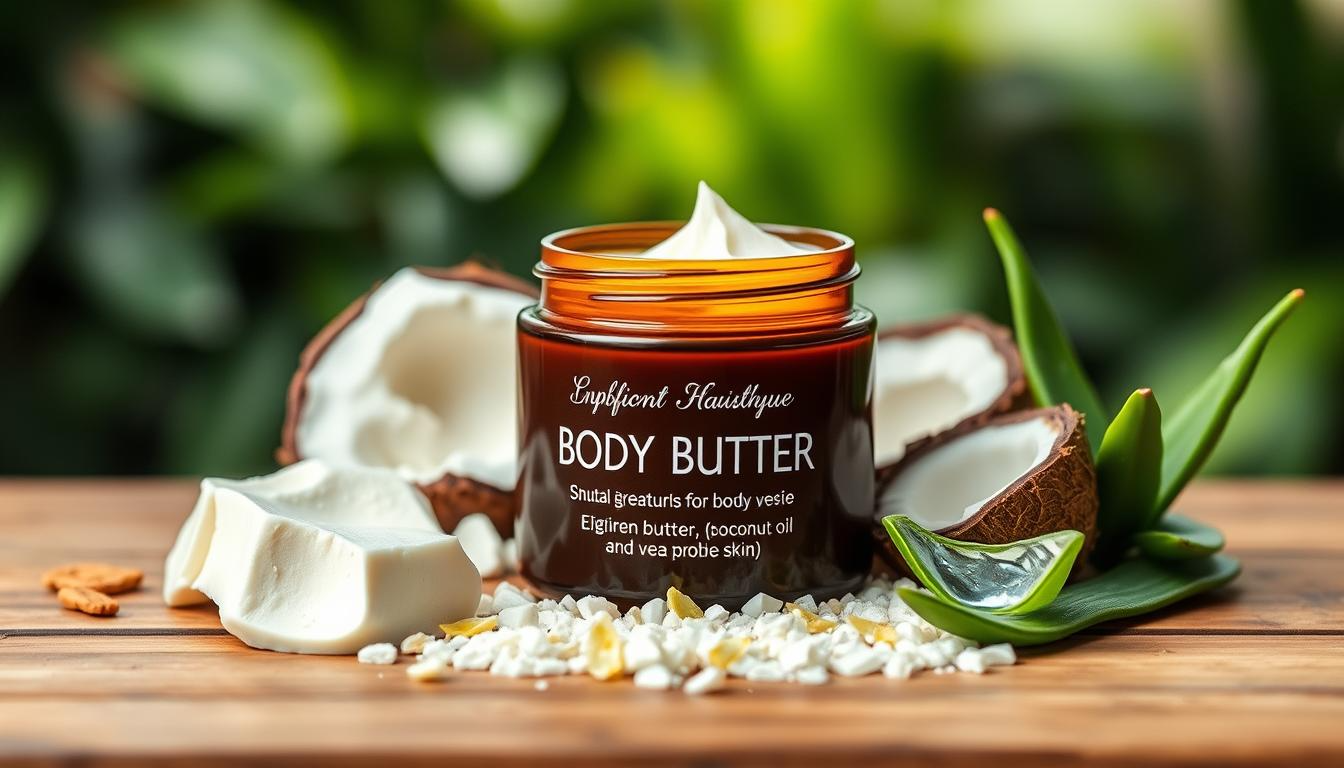Ever wondered why our skin gets dry sometimes, especially in winter? It’s often due to how we care for it. Our skin faces many challenges daily, like harsh weather, pollution, and aging. These can take away the skin’s natural moisture, making it dry and rough. That’s where body butter helps. After trying many skincare products, I can say body butter is a big deal in skincare.
In this article, I’ll share my journey to help you find your perfect body butter. Whether you want something moisturizing, natural, or budget-friendly, I’ve got you covered. By the end, you’ll know which body butter is best for your skin and budget.
What is Body Butter?
Body butter is a luxurious skincare product that deeply moisturizes and nourishes our skin. It has a richer texture than regular lotions, filled with plant-based butter and oils.
“The whipped body butter formula makes it smooth and creamy, gliding easily on the skin for intense moisture and hydration.” Dr. Josh Axe, DC, DNM
This moisturizing body butter uses shea butter, cocoa butter, and mango butter. They make the skin soft, smooth, and radiant. The body butter texture is thicker, making it great for dry skin.
85% of dermatologists recommend thick, rich body butters for hydration.
Don’t Forget to Check This Out: Best Body Butter for Black Skin: Editors’ Picks
Types of Body Butters
Body butter is great for soothing dry skin, improving texture, or just pampering yourself. They are a versatile and effective skincare solution. Here are some common types of body butters:
1. Shea Butter: Comes from the nuts of the Shea tree; it’s rich in vitamins A, E, and F. It deeply moisturizes and has anti-inflammatory and healing properties.
2. Cocoa Butter: From cocoa beans, it has a rich texture and a pleasant chocolate scent. It’s highly moisturizing and helps reduce scars and stretch marks.
3. Mango Butter: From mango fruit kernels, it’s lightweight yet moisturizing. It’s rich in vitamins A, C, and E, soothing, and regenerative.
4. Coconut Butter: Made from coconut oil, it has antibacterial and antifungal properties. It deeply hydrates and has a tropical scent.
5. Almond Butter: From sweet almonds, it’s rich in vitamins E and A. It emollients and softens the skin.
6. Avocado Butter: From avocado oil, it’s rich in fatty acids and vitamins. It’s great for dry and aging skin, nourishing and regenerative.
7. Olive Butter: From olive oil, it’s packed with antioxidants and vitamins. It’s excellent for moisturizing and rejuvenating dry, damaged skin.
8. Jojoba Butter: Made from jojoba oil, it has a consistency like the skin’s natural sebum. It’s highly moisturizing and balances oil production.
9. Kokum Butter: From the seeds of the Kokum tree, it’s non-comedogenic and heals and regenerates skin cells. It’s good for sensitive or acne-prone skin.
10. Hemp Seed Butter: Made from hemp seed oil, it’s rich in omega fatty acids and anti-inflammatory properties. It’s excellent for soothing and hydrating the skin.
11. Cupuaçu Butter: From the seeds of the Cupuaçu fruit, it locks in moisture and improves skin elasticity. It has a light, creamy texture.
12. Babassu Butter: From the Babassu palm, it’s lightweight and absorbs quickly. It’s cooling and soothing, ideal for sensitive skin.

Best Homemade Body Butter Works for Me?
As I have sensitive skin, finding the right moisturizer is quite a challenge for me. Sensitive skin often reacts to fragrances, chemicals, and even some natural ingredients.
I’ve tried many products, from thick creams to thin lotions. But honestly, nothing works best for me. Determined to find a solution, I decided to make and test four different types of body butters—Shea Butter, Cocoa Butter, Mango Butter, and Avocado Butter—to see which one would be best for my delicate skin.
I’ll also suggest a commercial product for each type that might be best for sensitive skin.
Shea butter
How I Made It at Home:
Shea butter is a classic and one of the most popular types of body butter. To make my own shea body butter, I used 220 grams of raw, unrefined shea butter, 110 grams of coconut oil, and a 2/3 drops of lavender oil for fragrance. I melted the shea butter and coconut oil in a double boiler, then let it cool slightly. After that, I whipped it with a hand mixer until it was fluffy. Finally, I added the lavender oil and whipped it again to blend everything together.
How I Use It on My Skin:
I applied the shea body butter after showering, while my skin was still slightly damp. This helped to lock in moisture. I focused on the driest areas of my body, like my elbows, knees, and feet. The texture was thick and rich, which felt luxurious as I massaged it into my skin.
Performance:
Shea butter deeply moisturized my skin. It absorbed very well, leaving my skin feeling soft and smooth without being greasy. The lavender essential oil adds a calming scent, making it ideal for use before bedtime. After using it consistently for a week, I noticed a significant improvement in the texture of my skin, particularly in the rough areas.
Tips:
Shea butter is an excellent choice if you have dry or sensitive skin. It provides intense hydration and has a soothing effect. If you’re looking for something to combat dry patches or eczema, this could be your go-to. However, if you have oily or acne-prone skin, this might be a bit too heavy.
Product Suggestion:
If DIY isn’t your thing, you might want to try L’Occitane Shea Butter Ultra Rich Body Cream. It’s enriched with 25% shea butter, offering similar benefits to the homemade version with a more refined texture.

Cocoa Butter
How I Made It at Home:
Cocoa butter is another rich, nourishing butter that’s known for its pleasant chocolatey scent. To make it at home, I combined 220 grams of raw cocoa butter with 110 grams of sweet almond oil and added 2 drops of vanilla extract. Like the shea butter, I melted the ingredients together and whipped them until they became fluffy. The vanilla enhanced the natural scent of the cocoa butter, making it smell absolutely delicious.
How I Use It on My Skin:
I used the cocoa butter in the same way as the shea butter—right after a shower when my skin was slightly damp. I found it particularly effective on my legs and arms, where my skin tends to be the driest.
Performance:
Cocoa butter is incredibly moisturizing and has a fantastic natural scent. It took a little longer to absorb into my skin compared to shea butter, but once it did, my skin felt smooth and supple. The cocoa butter also provided a slight sheen, giving my skin a healthy glow. After using it for a few days, my skin felt more elastic and hydrated.
Tips:
Cocoa butter is great for dry to normal skin types and works wonders in improving skin elasticity. It’s a bit heavier than shea butter, so it might not be ideal for oily skin. Yet, if you enjoy the scent of chocolate and want to indulge your senses while moisturizing, this is the body butter for you.
Product Suggestion:
For those who prefer a store-bought option, Palmer’s Cocoa Butter Formula is a classic. It’s known for its ability to improve skin texture and elasticity, and it smells divine.

Mango Butter
How I Made It at Home:
Making mango butter was exciting for me. I mixed 220 grams of raw mango butter with 110 grams of jojoba oil and a bit of sweet orange essential oil. Then, I melted the ingredients, cooled them, and whipped them until fluffy. The sweet orange oil added a refreshing scent to the mango butter.
How I Use It on My Skin:
I used mango butter in the morning because it’s light and not greasy. It worked well on dry areas and as a body moisturizer.
Performance:
Mango butter is lightweight yet deeply hydrating, making it perfect for normal to oily skin types. It absorbs quickly without leaving a greasy feel. The tropical scent makes my morning routine feel luxurious. My skin stayed soft and moisturized all day.
Tips:
Mango butter is ideal if you’re looking for a lighter moisturizer that still offers plenty of hydration. It’s great for normal to oily skin, not clogging pores or feeling greasy. It also smooths out fine lines and will make your skin feel firmer.
Product Suggestion:
If you prefer to buy, try Tree Hut Shea Moisturizing Body Butter, Tropical Mango. It combines mango butter with other natural oils for lightweight hydration.

Avocado Butter
How I Made It at Home:
Avocado butter was a new experience for me. I mixed 220 grams of raw avocado butter with 110 grams of olive oil and a few drops of rosemary essential oil. Then, I melted the ingredients, cooled them, and whipped until creamy.
How I Use It on My Skin:
Avocado butter was versatile for me. I used it morning and night, focusing on dry areas. It was also great for my hands and feet.
Performance:
Avocado butter is extremely nourishing and is especially good for mature or very dry skin. It has a rich texture that feels luxurious. It took a bit to absorb but left my skin soft and hydrated. The rosemary scent was refreshing.
Tips:
Avocado butter is fantastic for very dry or mature skin that needs extra nourishment. It’s a bit heavy, so not ideal for oily skin. But, it’s great for serious moisture or skin elasticity and repair.
Product Suggestion:
For a ready-made option, try Kiehl’s Creme de Corps Nourishing Dry Body Oil. It includes avocado oil and provides deep hydration without feeling heavy, making it a great alternative to homemade avocado butter.

Final Thoughts: Which Body Butter Works Best for Me?
If I had to choose just one, it would be shea butter. It’s rich and moisturizing, perfect for dry skin. But each body butter has its own benefits. The best one for you depends on your skin type and what you like.
For dry or sensitive skin, shea butter is a great choice. If you want a luxurious scent and a bit of shine, cocoa butter might be perfect. Mango butter is great for those who want hydration without feeling heavy. It’s ideal for normal to oily skin. And avocado butter is perfect for mature or very dry skin.
Whatever body butter you pick, your skin will love the extra care and moisture. Happy moisturizing!
Frequently Asked Questions
Q: When should I use body butter?
Answer: Body butter is best used after a shower or bath when your skin is still slightly damp, as it helps to lock in moisture. It can also be applied before bedtime to nourish your skin overnight or whenever your skin feels dry or needs extra hydration.
Q: Can I use body butter on my face?
Answer: While body butter is excellent for the body, it is usually too heavy for the face, especially for those with oily or acne-prone skin. However, if you have very dry or mature skin, a small amount can be used on the face. It’s best to do a patch test first to ensure there’s no irritation.
Q: Can body butter help with stretch marks and scars?
Answer: Yes, body butter, especially those containing cocoa or shea butter, can help improve the appearance of stretch marks and scars over time. These ingredients are rich in vitamins and essential fatty acids that help to nourish the skin and promote elasticity.
Q: Does body butter expire?
Answer: Yes, body butter can expire, especially if it contains natural ingredients without preservatives. Most body butters have a shelf life of 6 to 12 months once opened. To prolong its shelf life, store it in a cool, dry place, away from direct sunlight.

